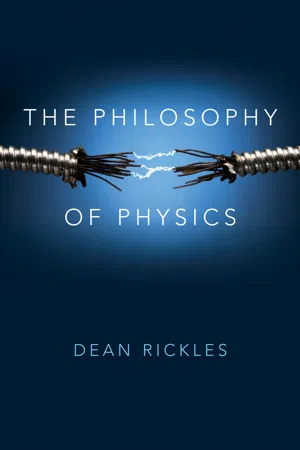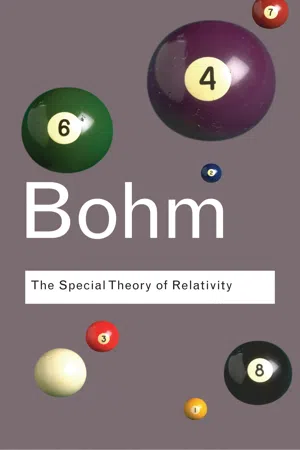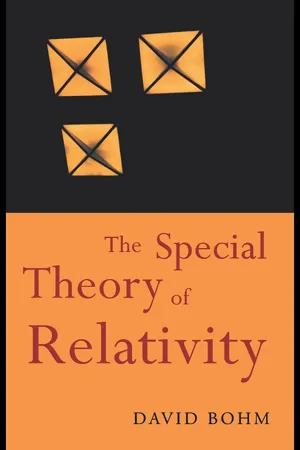Physics
Frame Analysis
Frame analysis in physics refers to the process of analyzing physical phenomena within a specific reference frame. It involves understanding how motion, forces, and other physical quantities are described and measured relative to a particular frame of reference. By using frame analysis, physicists can effectively study and interpret the behavior of objects and systems in motion.
Written by Perlego with AI-assistance
Related key terms
Related key terms
1 of 4
Related key terms
1 of 3
3 Key excerpts on "Frame Analysis"
- eBook - ePub
- Dean Rickles(Author)
- 2016(Publication Date)
- Polity(Publisher)
what it is to be a specially relativistic (or Galilean relativistic or thermodynamic, and so on) system. While the ‘normal’ laws of a theory might involve a reference to some specific type of system (particular particles or fields, for example), these meta-laws float above such details: they are far more general, and therefore also more robust (i.e. to changes in the specific details of the theories that implement the principles). For example, special relativity was devised before quantum mechanics came about, yet it applies just as well in quantum mechanics as it does in classical physics.Often, as seen above, these principles and laws concern the extent to which the reference frame, from which observations are made, is arbitrary. A reference frame can simply be understood to be a set of coordinates (x, y, z), which we can think of as a spatial frame in which measurements will be ‘recorded,’ and a time coordinate t, which we can think of as the reading of ‘clock time’ for these measurements. This is the laboratory of physics, though here it is presented rather abstractly.Laboratories will usually vary between observers. For example, experiments performed on the international space station will occupy a different frame of reference to yours in your office or wherever you are reading this book. One can imagine other experiments taking place in a laboratory that is rotating (i.e. spinning on its own axis), which would involve a different reference frame. In order to make sense of these differences we need some way of relating them to one another, so that arbitrary features of the reference frame are not mistaken for features of reality. Transformation laws link the various reference frames, and allow us to see that the physical quantities that we measure do not depend on the frame in which they are measured: we extract the physical structure as that which is left invariant between the frames. As we see in the next chapter, these amount to symmetry principles. - eBook - ePub
- David Bohm(Author)
- 2015(Publication Date)
- Routledge(Publisher)
11 Analysis of Space and Time Concepts in Terms of Frames of Reference In the preceding chapter we saw that both theoretically and experimentally, the older concepts of space and time lead to a critical problem, which is very deep in the sense that it goes to the root of basic notions that are at the foundation of physics, as well as of a large part of our everyday, technical, and industrial activities. This problem is of a novel kind. For the difficulty was not that the Lorentz theory disagreed with experiment. On the contrary, it was in accord with all that had been observed at the time of Lorentz, and in fact, it is also in accord with all that has been observed since then. The problem was rather that the fundamental concepts entering into the Lorentz theory, i.e., the “true” time and “true” space coordinates as measured by apparatus that would be at rest in the ether, were in fact completely ambiguous. For, as we have seen, it was deduced on the basis of the Lorentz theory itself that no means at all could ever be found to correct the readings of laboratory instruments to give the values of the “true” coordinates and times. Indeed, since these properties of the “ether” frame of coordinates cancel out of all observable results, it makes no difference whether we assume that there is such a frame or not. Of course, if some properties of the ether had turned out to be observable, then the ether would have had a further physical significance. But if none of its properties are observable, it can be said to have only the role of serving as a vehicle for the notions of absolute space and time which are basic in Newtonian mechanics - eBook - ePub
- David Bohm(Author)
- 2003(Publication Date)
- Routledge(Publisher)
XI Analysis of Space and Time Concepts in Terms of Frames of Reference In the preceding chapter we saw that both theoretically and experimentally, the older concepts of space and time lead to a critical problem, which is very deep in the sense that it goes to the root of basic notions that are at the foundation of physics, as well as of a large part of our everyday, technical, and industrial activities. This problem is of a novel kind. For the difficulty was not that the Lorentz theory disagreed with experiment. On the contrary, it was in accord with all that had been observed at the time of Lorentz, and in fact, it is also in accord with all that has been observed since then. The problem was rather that the fundamental concepts entering into the Lorentz theory, i.e., the “true” time and “true” space coordinates as measured by apparatus that would be at rest in the ether, were in fact completely ambiguous. For, as we have seen, it was deduced on the basis of the Lorentz theory itself that no means at all could ever be found to correct the readings of laboratory instruments to give the values of the “true” coordinates and times. Indeed, since these properties of the “ether” frame of coordinates cancel out of all observable results, it makes no difference whether we assume that there is such a frame or not. Of course, if some properties of the ether had turned out to be observable, then the ether would have had a further physical significance. But if none of its properties are observable, it can be said to have only the role of serving as a vehicle for the notions of absolute space and time which are basic in Newtonian mechanics
Index pages curate the most relevant extracts from our library of academic textbooks. They’ve been created using an in-house natural language model (NLM), each adding context and meaning to key research topics.
Explore more topic indexes
Explore more topic indexes
1 of 6
Explore more topic indexes
1 of 4


